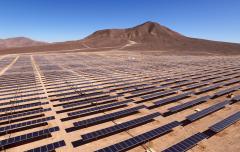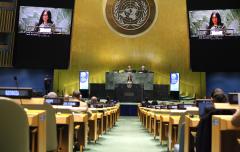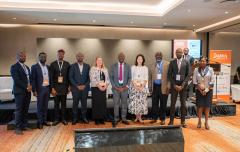Humanizing Energy: Interview with Kandeh Yumkella, Special Representative of the UN Secretary General for Sustainable Energy for All
Your position is new at the UN. What does it feel like to be able to start something brand-new in the sustainable energy arena, and energy poverty in general?
For me personally, it was a culmination of my efforts over a period of almost a decade, trying to argue the case that I don’t see the poor developing countries, particularly those in Africa, being able to achieve their goals without access to energy. There is a direct link between income poverty and energy poverty. Getting this appointment was an exciting oppor- tunity because suddenly the UN believed we must institutionalize these issues in the context of ongoing development discussions. Now, hav- ing said that, I have to add that setting up a new institutional framework for this is more challeng- ing than I thought. But it’s an exciting challenge.
What has energy poverty meant to you in your own life, growing up in Sierra Leone and attending university there?
Let me put it this way. I was in Sierra Leone several weeks ago and I think of my trips there as going “back to the future.” During my visit, we celebrated the 50th anniversary of the university that I attended as an undergrad, over 30 years ago. The same problems still exist: lack of regular electricity supply, lack of clean water supply. I remembered that the second demonstration I co- led against the administration of that university, at age 19, was about lack of energy—administrators could not provide electricity and clean water to the dormitory. Thirty years later, here I am still trying to deal with the same issues.
How does climate change impact the energy issue?
Climate change makes it more urgent to take action on global energy systems—otherwise, we are all condemned to climate hell. Also, I see the inequity and unfairness of the global economic system through the lens of climate change. Those who pollute the least will suffer the most from “business as usual.” Africa is a good example. They account for less than 3 percent of greenhouse-gas emissions, but when you look at climate change scenarios, going into 2030 to 2050, the worst impact will be in Africa. They lose 50 percent of their crop yield. For each one degree rise in global temperature, in Central Africa and parts of the Sahel, they experience 1.5 degrees—for something they did not cause. There will be an increase in diseases with extreme weather events, and because they don’t have the economic wealth, they are less resilient. Climate change is the biggest risk multiplier.
What role do public-private partnerships play in solving the problem of access to energy?
Public-private partnerships will be the key to sustainable energy for all. That’s why our initia- tive, SEforALL, is what we call a mega partnership or a mega creative coalition. We have always included CEOs of private corporations, govern- ment leaders, and leaders of civil society. To achieve universal access to energy by 2030, we need about a $50 billion dollar investment per year. The total official development assistance is $9 billion. To reach $50 billion, you need private money, not given as aid but as investments blended with public finance. We want to create markets and incentives to deploy technology and get energy access for people. The big question is how you create this and get the companies to be excited to make money and change the world. That’s our challenge.
What do you say to persuade government officials who need to be convinced to make access to energy a priority?
Even in the very poor countries, many govern- ment officials don’t see the link. They have been focusing, legitimately, on energy for economic growth. I give them another reason, sharing with these leaders my views on the social dimensions of energy and providing some new data—like the fact that 4 million premature deaths each year are due to household air pollution. It’s worse than HIV and malaria combined. They say, “Oh really?” Then I tell them, “Your women spend 20 hours a week collecting firewood and water. If they had solar power to pump that, it would free them up and the girls could go to school.” Now people begin to see the numbers and it begins to resonate. This is why, at the beginning of the decade of Sustainable Energy for All, we are dedicating the first two years to energy, women, and children’s health. This is the way to human- ize the energy debate.
Which countries are handling access to energy the right way?
Brazil, China, and India are all doing this very well. Brazil pushed electricity for all; now they are at about 90 percent electrification. The cur- rent president, when she was Minister of Energy, led the campaign for energy access tied to poverty reduction and social inclusion. That was their message. And they saw the impact immedi- ately. You bring energy to the rural community, and shops open up. You bring energy to the rural community, and they process more agricultural products. Incomes go up, and they buy more consumer goods. These countries, and many others, have domesti- cated renewable energy technologies—reducing their size, making their costs lower, and getting women to install the equipment themselves, leading to social inclusion. Morocco, which is at almost 90 percent electrifi- cation, is another good example. They are doing everything with solar and wind. And Bhutan might be one of those countries in the next five to 10 years that achieves all the targets for renewable energy. On rapid electrification, South Africa is a big success. Same with Vietnam and Cambodia.
You always make it a point to say that sustainable energy for all is not just about poor countries. What do you mean?
It is about you and me living in the first world, doing our share. Germany is a great example. Germans are doing distributive rooftop solar power to show that consumers of energy can become “prosumers”—they consume, and they produce. They have their solar power, they use some of it, and they supply the rest of it to the grid. This shows that if you go solar, you reduce your emissions, but your lifestyle does not suffer. You pay a little more. But you and I can afford it, can’t we? The same principle applies to energy efficiency. The Danes have reduced their energy intensity more than any other nation. Their GDP grew as their energy consumption declined at the same time. They have one of the best energy intensity measurements, but now they are pushing an even greater ambition: to have more renewables in their energy mix and reduce their footprint. The big question is how to convince the consumers to change their behavior, and incentivize this change.
It sounds like you’re saying that the importance of incentives can’t be overstated.
Incentives are important and regulations also matter. If you don’t regulate, people will find short cuts. If you’re going to create new markets, you have to incentivize research and develop- ment and bring private investment in. You need to incentivize corporations as well as individuals. Public policy is also important, generally, for creating that enabling environment that includes incentives, regulation, and also accountability measures. This is the suite of policies that you need if you want to see this energy revolution spread across the world.
To download a full copy of the interview in PDF format click here
This interview by Alison Buckholtz was originally published at www.ifc.org/handshake



